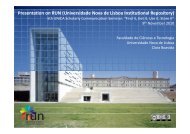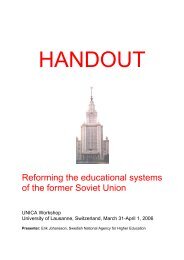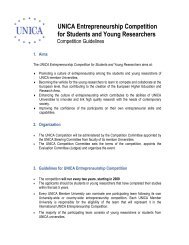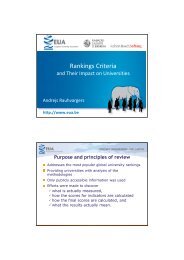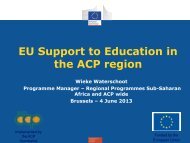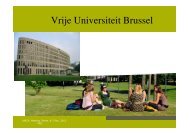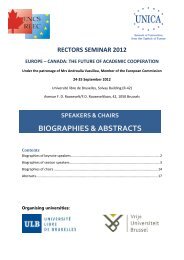Study on the economic and technical evolution of the scientific ...
Study on the economic and technical evolution of the scientific ...
Study on the economic and technical evolution of the scientific ...
You also want an ePaper? Increase the reach of your titles
YUMPU automatically turns print PDFs into web optimized ePapers that Google loves.
per subscripti<strong>on</strong> for 5000 subscribers (86%<br />
decrease; see Tenopir <strong>and</strong> King (2000), figure<br />
11 page 266).<br />
However, <strong>the</strong> questi<strong>on</strong> we will deal with here is<br />
slightly different, since we will let quality vary.<br />
Indeed, <strong>the</strong> data we have c<strong>on</strong>cern total<br />
citati<strong>on</strong>s ra<strong>the</strong>r than circulati<strong>on</strong> or costs, which<br />
are very hard to obtain. But looking at <strong>the</strong><br />
interacti<strong>on</strong> between prices <strong>and</strong> citati<strong>on</strong>s can in<br />
our view be instructive.<br />
Higher citati<strong>on</strong>s go h<strong>and</strong>-in-h<strong>and</strong> with higher<br />
circulati<strong>on</strong>, which should reduce costs, but<br />
<strong>the</strong>re is also a counterbalancing effect <strong>on</strong><br />
costs, for example because higher-quality<br />
journals attract more submissi<strong>on</strong>s <strong>and</strong> have a<br />
higher rejecti<strong>on</strong> rate. Which effect should be<br />
expected to dominate?<br />
It is in fact possible to have an idea <strong>of</strong> <strong>the</strong><br />
proporti<strong>on</strong> <strong>of</strong> <strong>the</strong> total costs <strong>of</strong> an article that<br />
will increase with <strong>the</strong> level <strong>of</strong> quality for a<br />
given domain. Using <strong>the</strong> methodology <strong>of</strong><br />
Tenopir <strong>and</strong> King (2000) it is clear that some<br />
costs (e.g. refereeing) may increase while o<strong>the</strong>r<br />
costs should not vary much (e.g. print).<br />
Specifically, Tenopir <strong>and</strong> King (2000) distinguish<br />
Article processing costs, N<strong>on</strong>-article processing<br />
costs, Reproducti<strong>on</strong> costs, Distributi<strong>on</strong> costs<br />
<strong>and</strong> Publishing support costs. There is no<br />
reas<strong>on</strong> to believe that <strong>the</strong> Publishing support<br />
(general administrati<strong>on</strong>, taxes), Reproducti<strong>on</strong><br />
or Distributi<strong>on</strong> costs vary much with quality (as<br />
measured by citati<strong>on</strong>s for instance) <strong>of</strong> a journal<br />
in a given domain. The same holds for<br />
N<strong>on</strong>-article processing costs (table <strong>of</strong> c<strong>on</strong>tents,<br />
letters, editorials), which should not be<br />
correlated with quality.<br />
Some <strong>of</strong> <strong>the</strong> two remaining costs may be related<br />
to quality. Article processing costs include five<br />
sub costs, two <strong>of</strong> which may change substantially<br />
with quality <strong>of</strong> <strong>the</strong> review:<br />
• Fixed costs per issue, which should not<br />
change much;<br />
• Cost per page <strong>of</strong> receiving, processing, <strong>and</strong><br />
reviewing a manuscript: <strong>the</strong>se can increase<br />
substantially with <strong>the</strong> level <strong>of</strong> quality <strong>and</strong> in<br />
particular with <strong>the</strong> rejecti<strong>on</strong> rate. Rejecti<strong>on</strong> rates<br />
vary much more across domains than within a<br />
given domain but increase with quality;<br />
• Costs <strong>of</strong> editing <strong>and</strong> pro<strong>of</strong>-reading articles<br />
may also increase with <strong>the</strong> quality <strong>of</strong> <strong>the</strong><br />
journal;<br />
• Costs <strong>of</strong> compositi<strong>on</strong> <strong>and</strong> processing graphics<br />
should be quite stable;<br />
The costs, which vary with quality, thus<br />
represent, following <strong>the</strong> estimates <strong>of</strong> Tenopir<br />
<strong>and</strong> King (2000), a bit more than 60% <strong>of</strong> <strong>the</strong><br />
Article costs, which are <strong>the</strong>mselves <strong>on</strong>e third <strong>of</strong><br />
<strong>the</strong> costs <strong>of</strong> an article. This means that some<br />
twenty percent <strong>of</strong> <strong>the</strong> costs <strong>of</strong> producing an<br />
article vary with quality. This figure may seem<br />
low compared with <strong>the</strong> steep decrease <strong>of</strong> cost<br />
per subscripti<strong>on</strong> with <strong>the</strong> number <strong>of</strong><br />
subscripti<strong>on</strong>s. Moreover, apart from costs,<br />
higher quality journals have higher incomes.<br />
Besides <strong>the</strong> higher income from subscripti<strong>on</strong>,<br />
<strong>the</strong>y may charge for advertisement <strong>and</strong> sell<br />
more back issues <strong>and</strong> reprints. These additi<strong>on</strong>al<br />
incomes may be n<strong>on</strong>trivial.<br />
Average costs should <strong>the</strong>refore be expected to<br />
fall when citati<strong>on</strong> counts rise 37 .<br />
In <strong>the</strong> remainder <strong>of</strong> this secti<strong>on</strong>, we investigate<br />
empirically <strong>the</strong> relati<strong>on</strong> between journal prices,<br />
<strong>the</strong>ir for-pr<strong>of</strong>it or not-for-pr<strong>of</strong>it status <strong>and</strong> <strong>the</strong>ir<br />
quality measured by <strong>the</strong>ir citati<strong>on</strong> counts.<br />
We do this <strong>on</strong> a large sample <strong>of</strong> journals<br />
covering 22 <strong>scientific</strong> fields.<br />
3.1. DESCRIPTION OF THE DATABASE<br />
Many authors have provided evidence indicating<br />
that journals held by FP publishers are<br />
significantly more expensive than journals<br />
published by NFP organizati<strong>on</strong>s. However,<br />
<strong>the</strong>se studies are ei<strong>the</strong>r c<strong>on</strong>centrated <strong>on</strong> a<br />
precise domain 38 or aggregate many domains<br />
toge<strong>the</strong>r 39 . As will be clear later <strong>on</strong>, <strong>the</strong>re are<br />
wide differences across domains. This makes<br />
an analysis <strong>on</strong> a precise domain not very<br />
relevant for ano<strong>the</strong>r domain <strong>and</strong> may introduce<br />
a bias in studies that aggregate too many<br />
domains toge<strong>the</strong>r (an unbalanced database<br />
may introduce biases). This has led us to study<br />
journal prices in 22 domains <strong>of</strong> natural <strong>and</strong><br />
social sciences.<br />
28




